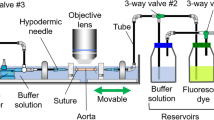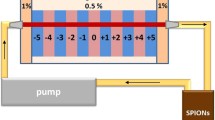Abstract
Interstitial fluid (ISF) flow through vascular adventitia has been discovered recently. However, its kinetic pattern was unclear. We used histological and topographical identification to observe ISF flow along venous vessels in rabbits. By magnetic resonance imaging (MRI) in live subjects, the inherent pathways of ISF flow from the ankle dermis through the legs, abdomen, and thorax were enhanced by paramagnetic contrast. By fluorescence stereomicroscopy and layer-by-layer dissection after the rabbits were sacrificed, the perivascular and adventitial connective tissues (PACTs) along the saphenous veins and inferior vena cava were found to be stained by sodium fluorescein from the ankle dermis, which coincided with the findings by MRI. The direction of ISF transport in a venous PACT pathway was the same as that of venous blood flow. By confocal microscopy and histological analysis, the stained PACT pathways were verified to be the fibrous connective tissues, consisting of longitudinally assembled fibers. Real-time observations by fluorescence stereomicroscopy revealed at least two types of spaces for ISF flow: one along adventitial fibers and another one between the vascular adventitia and its covering fascia. Using nanoparticles and surfactants, a PACT pathway was found to be accessible by a nanoparticle of <100 nm and contained two parts: a transport channel and an absorptive part. The calculated velocity of continuous ISF flow along fibers of the PACT pathway was 3.6–15.6 mm/s. These data revealed that a PACT pathway was a “slit-shaped” porous biomaterial, comprising a longitudinal transport channel and an absorptive part for imbibition. The use of surfactants suggested that interfacial tension might play an essential role in layers of continuous ISF flow along vascular vessels. A hypothetical “gel pump” is proposed based on interfacial tension and interactions to regulate ISF flow. These experimental findings may inspire future studies to explore the physiological and pathophysiological functions of vascular ISF or interfacial fluid flow among interstitial connective tissues throughout the body.
概要
目的
本文旨在进一步研究沿血管外膜组织液流动的运动学特征。
创新点
(1)静脉血管外膜及其周围结缔组织中的组织液连续流动至少存在两种空间:血管外膜中沿纤维表面空间的连续流动,血管外膜及其被膜之间的连续流动;(2)静脉血管外膜及其周围结缔组织中的组织液流动包含两部分:传输通道(transport channel)和吸收区(absorptive part);(3)静脉血管外膜中的组织液流动的空隙大小约在100 nm以下;(4)表面活性剂对静脉血管外膜及其周围结缔组织中的组织液流动模式具有显著的影响,包括降低组织液的流量、抑制外膜吸收区对于组织液的吸收、抑制外膜通道中的组织液流动等;(5)提出静脉血管外膜及其周围结缔组织中的组织液流动的动力机制假说:凝胶泵假说;(6)静脉血管内的血液流动呈螺旋状,提示管腔内很可能存在类似“枪膛线”结构。
方法
利用磁共振成像、体视荧光成像等技术,采用分层解剖法、组织学、电镜和共聚焦等分析方法,在动物实验中观察不同种类示踪剂所显示的组织液沿血管外膜及其周围结缔组织中的流动过程,包括磁共振对比剂、荧光素钠、不同粒径的金纳米颗粒、带不同电荷的表面活性剂等。
结论
血管外膜及其周围结缔组织是一种“缝隙样”生物多孔材料,包括传输通道和吸收区两部分;表面活性剂的影响提示外膜的多层组织液流动与界面张力有关;根据界面张力和界面相互作用提出了“凝胶泵”假说;这些实验发现对深入理解血管外膜中组织液流动的生理学和病理生理学功能,以及全身结缔组织网络中的“界面液体流动”提供了新的思路。
Similar content being viewed by others
References
Aukland K, Reed RK, 1993. Interstitial-lymphatic mechanisms in the control of extracellular fluid volume. Physiol Rev, 73(1):1–78. https://doi.org/10.1152/physrev.1993.73.1.1
Cenaj O, Allison DHR, Imam R, et al., 2021. Evidence for continuity of interstitial spaces across tissue and organ boundaries in humans. Commun Biol, 4:436. https://doi.org/10.1038/s42003-021-01962-0
Chen X, Cao GX, Han AJ, et al., 2008. Nanoscale fluid transport: size and rate effects. Nano Lett, 8(9):2988–2992. https://doi.org/10.1021/nl802046b
Hall JE, Guyton AC, 2011. The microcirculation and lymphatic system. In: Guyton and Hall Textbook of Medical Physiology, 12th Ed. Saunders, Philadelphia, p.180–182.
Holmberg K, Jönsson B, Kronberg B, et al., 2003. Surfactants and Polymers in Aqueous Solution, 2nd Ed. John Wiley & Sons, Chichester, UK, p.139–155. https://doi.org/10.1002/0470856424.ch6
Holmes MC, 1998. Intermediate phases of surfactant-water mixtures. Curr Opin Colloid Interface Sci, 3(5):485–492. https://doi.org/10.1016/S1359-0294(98)80022-8
Iliff JJ, Wang MH, Liao YH, et al., 2012. A paravascular pathway facilitates CSF flow through the brain parenchyma and the clearance of interstitial solutes, including amyloid β. Sci Transl Med, 4(147):147ra111. https://doi.org/10.1126/scitranslmed.3003748
Khan A, 1996. Phase science of surfactants. Curr Opin Colloid Interface Sci, 1(5):614–623. https://doi.org/10.1016/S1359-0294(96)80099-9
Levick JR, 1987. Flow through interstitium and other fibrous matrices. Q J Exp Physiol, 72(4):409–437. https://doi.org/10.1113/expphysiol.1987.sp003085
Li HY, Chen M, Yang JF, et al., 2012. Fluid flow along venous adventitia in rabbits: is it a potential drainage system complementary to vascular circulations? PLoS ONE, 7(7):e41395. https://doi.org/10.1371/journal.pone.0041395
Li HY, Yang CQ, Lu KY, et al., 2016. A long-distance fluid transport pathway within fibrous connective tissues in patients with ankle edema. Clin Hemorheol Microcirc, 63(4):411–421. https://doi.org/10.3233/CH-162057
Li HY, Han D, Li H, et al., 2017. A biotic interfacial fluid transport phenomenon in the meshwork of fibrous connective tissues over the whole body. Prog Physiol Sci, 48(2):81–87 (in Chinese). https://doi.org/10.3969/j.issn.0559-7765.2017.02.001
Li HY, Yang CQ, Yin YJ, et al., 2019. An extravascular fluid transport system based on structural framework of fibrous connective tissues in human body. Cell Prolif, 52(5):e12667. https://doi.org/10.1111/cpr.12667
Li HY, Yin YJ, Yang CQ, et al., 2020. Active interfacial dynamic transport of fluid in a network of fibrous connective tissues throughout the whole body. Cell Prolif, 53(2):e12760. https://doi.org/10.1111/cpr.12760
Pan H, Wang BH, Li ZB, et al., 2019. Mitochondrial superoxide anions induced by exogenous oxidative stress determine tumor cell fate: an individual cell-based study. J Zhejiang Univ-Sci B (Biomed & Biotechnol), 20(4):310–321. https://doi.org/10.1631/jzus.B1800319
Qian M, Niu LL, Wang YP, et al., 2010. Measurement of flow velocity fields in small vessel-mimic phantoms and vessels of small animals using micro ultrasonic particle image velocimetry (micro-EPIV). Phys Med Biol, 55(20): 6069–6088. https://doi.org/10.1088/0031-9155/55/20/003
Rennels ML, Gregory TF, Blaumanis OR, et al., 1985. Evidence for a ‘Paravascular’ fluid circulation in the mammalian central nervous system, provided by the rapid distribution of tracer protein throughout the brain from the subarachnoid space. Brain Res, 326(1):47–63. https://doi.org/10.1016/0006-8993(85)91383-6
Tokunaga TK, Wan JM, 1997. Water film flow along fracture surfaces of porous rock. Water Resour Res, 33(6):1287–1295. https://doi.org/10.1029/97WR00473
Tuller M, Or D, Dudley LM, 1999. Adsorption and capillary condensation in porous media: liquid retention and interfacial configurations in angular pores. Water Resour Res, 35(7):1949–1964. https://doi.org/10.1029/1999WR900098
van Oss CJ, 2007. Development and applications of the interfacial tension between water and organic or biological surfaces. Colloids Surf B: Biointerfaces, 54(1):2–9. https://doi.org/10.1016/j.colsurfb.2006.05.024
Whitby M, Cagnon L, Thanou M, et al., 2008. Enhanced fluid flow through nanoscale carbon pipes. Nano Lett, 8(9):2632–2637. https://doi.org/10.1021/nl080705f
Wiig H, Rubin K, Reed RK, 2003. New and active role of the interstitium in control of interstitial fluid pressure: potential therapeutic consequences. Acta Anaesthesiol Scand, 47(2):111–121. https://doi.org/10.1034/j.1399-6576.2003.00050.x
Wiig H, Gyenge CC, Tenstad O, 2005. The interstitial distribution of macromolecules in rat tumours is influenced by the negatively charged matrix components. J Physiol, 567(2):557–567. https://doi.org/10.1113/jphysiol.2005.089615
Ziemys A, Kojic M, Milosevic M, et al., 2012. Interfacial effects on nanoconfined diffusive mass transport regimes. Phys Rev Lett, 108(23):236102. https://doi.org/10.1103/PhysRevLett.108.236102
Zhu Y, Zhang Q, Shi X, et al., 2019. Hierarchical hydrogel composite interfaces with robust mechanical properties for biomedical applications. Adv Mater, 31(45):1804950. https://doi.org/10.1002/adma.201804950
Acknowledgments
This study was supported by the National Natural Science Foundation of China (Nos. 82050004 and 81141118), the Beijing Hospital Clinical Research 121 Project (No. 121-2016002), and the National Basic Research Program of China (No. 2015CB554507). We thank Ms. Siu TUEN, Lucy Chan LAU, Mr. Waichun TIN, and Weiwu HU for their financial support, Prof. Peisu XIA for her help with data analysis, and Prof. Wentai LEE for his assistance with English language corrections to this manuscript.
Author information
Authors and Affiliations
Contributions
Hongyi LI conceived the original ideas and concepts, contributed materials, designed the experiments, and wrote the paper. Hongyi LI, Xiaoliang CHEN, and You LYU performed the experiments. Hongyi LI, Qi HUA, Fusui JI, and Hua LI analyzed the data. Hongyi LI and Yajun YIN analyzed the interfacial transport pattern. Hongyi LI and Bei LI prepared pictures and videos. All authors have read and approved the final manuscript and, therefore, have full access to all the data in the study and take responsibility for the integrity and security of the data.
Corresponding authors
Additional information
Supplementary information
Videos S1–S7
Compliance with ethics guidelines
Hongyi LI, You LYU, Xiaoliang CHEN, Bei LI, Qi HUA, Fusui JI, Yajun YIN, and Hua LI declare that they have no conflict of interest.
All institutional and national guidelines for the care and use of laboratory animals were followed.
Supplementary information
Rights and permissions
About this article
Cite this article
Li, H., Lyu, Y., Chen, X. et al. Layers of interstitial fluid flow along a “slit-shaped” vascular adventitia. J. Zhejiang Univ. Sci. B 22, 647–663 (2021). https://doi.org/10.1631/jzus.B2000590
Received:
Accepted:
Published:
Issue Date:
DOI: https://doi.org/10.1631/jzus.B2000590




